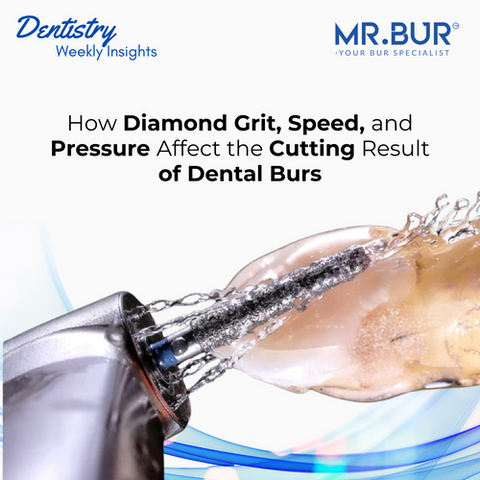Primary teeth, commonly known as baby teeth, play a vital role in a child's oral development. Despite being temporary, they are essential for speech development, effective chewing, and maintaining proper spacing for permanent teeth. Pediatric dentists prioritize the preservation of primary teeth to ensure the child's long-term oral health. One of the most crucial tools for achieving this is the dental bur. From cavity preparations to pulpotomies, dental burs are integral in pediatric dentistry, offering the precision and control needed to deliver the best outcomes for young patients. In this article, we explore the role of dental burs in pediatric dental care, focusing on their shapes, functions, and importance in maintaining healthy primary teeth.
The Unique Needs of Primary Teeth in Pediatric Dentistry
Primary teeth differ significantly from permanent teeth in both structure and treatment needs. The enamel on primary teeth is approximately 50% thinner than that of permanent teeth, making them more vulnerable to decay, as noted by the American Academy of Pediatric Dentistry (AAPD). Furthermore, primary teeth have larger pulp chambers and shorter roots, requiring careful handling during procedures to avoid complications. Pediatric dentists must take these anatomical differences into account to ensure the safe preservation of primary teeth, using specialized tools such as pediatric-specific dental burs to achieve optimal results.
In one case, a five-year-old patient presented with deep caries in a primary molar. The decay was extensive, close to the pulp, and required a pulpotomy. The pediatric dentist selected a small, round diamond dental bur to precisely remove the decayed tissue without damaging the surrounding healthy tooth structure. This highlighted the critical role that the correct dental bur plays in preserving primary teeth while minimizing trauma and ensuring the child’s comfort during treatment.
Why Preserving Primary Teeth Is Crucial for Long-Term Oral Health
Preserving primary teeth is essential because they serve as placeholders for permanent teeth, helping to maintain the proper alignment and spacing within the dental arch. According to the American Dental Association(ADA), the early loss of primary teeth can lead to misalignment of permanent teeth, increasing the likelihood of orthodontic problems in the future. Ensuring that primary teeth remain healthy and intact until natural exfoliation is vital for preventing malocclusion and reducing the need for future orthodontic treatments.
The Role of Dental Burs in Pediatric Dentistry: Shapes and Functions
Cavity Preparation
Cavity preparation is one of the most common procedures in pediatric dentistry. With the AAPD reporting that over 40% of children experience tooth decay by kindergarten, the need for precision in treating decayed primary teeth is critical. Dental burs designed for pediatric use are essential for achieving the accurate removal of decayed material while preserving healthy tooth structure. The use of small, fine-cutting dental burs—such as round, pear-shaped, and flame-shaped burs—enables dentists to precisely target the carious areas without causing unnecessary damage to the tooth.
- Round Burs: These burs are often used to initiate the removal of decayed tissue, especially in deep cavities that approach the pulp. They are ideal for accessing and cleaning carious lesions efficiently and gently, minimizing trauma to the surrounding tooth structure.
- Pear-Shaped Burs: Frequently used for cavity preparation, pear-shaped burs are excellent for removing decay while shaping the cavity to accommodate restorative materials. Their tapered design helps create smooth surfaces, which is critical in pediatric cases where minimizing stress on the tooth is a priority.
- Flame-Shaped Burs: These burs are effective in refining the cavity preparation and creating well-defined margins. Their narrow profile allows for precision in tight spaces, particularly in the small mouths of pediatric patients.
Studies published in the Journal of Clinical Pediatric Dentistry demonstrate that using diamond burs for cavity preparation reduces treatment time by 25%, improving efficiency and outcomes in pediatric dental care.
Pulpotomies and Endodontic Procedures
In cases where decay reaches the pulp, pulpotomies are commonly performed to preserve the tooth. Pediatric dentists rely on small, sharp dental burs—such as small round burs or tapered fissure burs—to accurately remove decayed tissue near the pulp without exposing it. The use of these burs minimizes trauma and increases the likelihood of a successful pulpotomy. A 2021 study in the Journal of Pediatric Dentistry found that the use of round diamond burs reduced the likelihood of pulpal exposure by 15%, leading to more favorable long-term outcomes for the affected teeth.
The Importance of Selecting the Right Dental Bur Shape in Pediatric Procedures
The selection of dental bur shapes is crucial in pediatric dentistry. The anatomy of primary teeth and the unique challenges presented by a child’s smaller mouth require burs that allow for precision and reduced chair time. Pediatric dental burs typically feature smaller sizes, finer cutting edges, and shorter shanks to accommodate the delicate structures of primary teeth.
- Short Shank Diamond Dental Burs: Mini Shank Diamond burs are preferred for their ability to cut smoothly through enamel and dentin while minimizing heat generation, reducing discomfort for pediatric patients with limited mouth opening.
Enhancing Preventive Care with Dental Burs
Beyond restorative procedures, dental burs also play a key role in preventive care for children. For example, the application of sealants to protect molars from future decay can be enhanced by using small, rounded burs to clean and prepare the tooth surface. This process helps ensure a strong bond between the sealant material and the tooth enamel, effectively reducing the risk of future caries.
Conclusion
Dental burs are essential in pediatric dentistry, offering the precision and gentleness needed to treat the unique anatomical characteristics of primary teeth. From cavity preparation to pulpotomies, selecting the right shape and type of dental bur is critical in ensuring the success of pediatric dental treatments. With their role in preserving tooth structure, minimizing trauma, and supporting preventive care, dental burs contribute significantly to long-term oral health outcomes for children. As advancements in dental technology continue to evolve, pediatric dentists will continue to rely on high-quality dental burs to deliver optimal care and ensure the best possible outcomes for their young patients.
MR. BUR US provides a wide range of dental burs globally.
Diamond Burs, Carbide Burs, Surgical & Lab Use Burs, Endodontic burs, IPR Kit, Crown Cutting Kit, Gingivectomy Kit, Root Planning Kit, Composite Polishers, High Speed Burs, Low Speed Burs
Subscribe our newsletter now!



